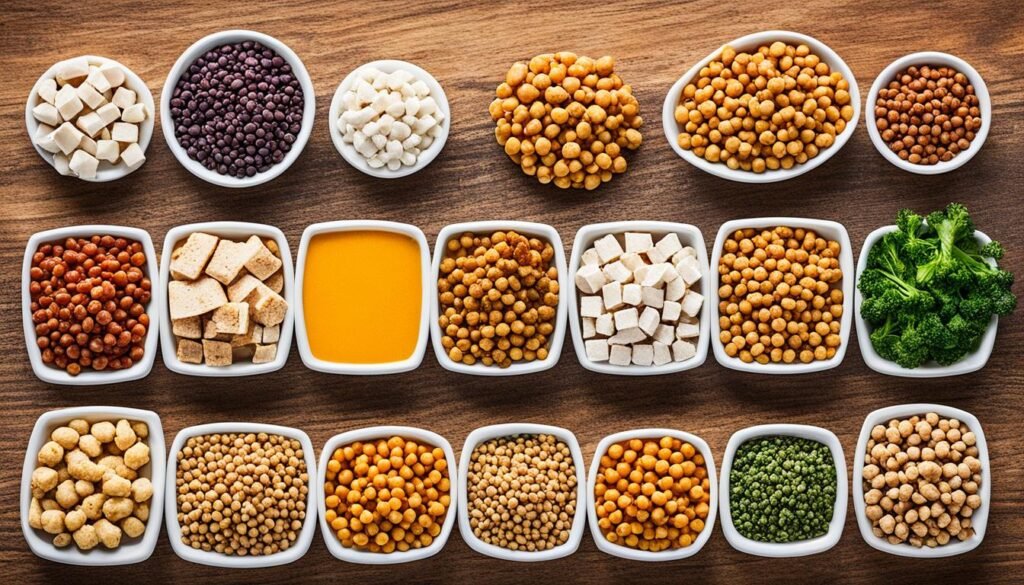How to start eating healthy for beginners?
Being a busy professional can affect how we eat. Work and family responsibilities sometimes lead us to choose fast, processed meals over healthy foods. But learning to eat well is not as hard as it seems. It’s about making simple changes to what we eat. This can help us feel and look better.
I want to give you some easy tips for starting to eat better. It’s all about making small changes over time and sticking to them. Understanding what a balanced diet is and focusing on the right kind of carbs is key. Also, don’t forget to add plenty of fruits, vegetables, and healthy proteins to your meals. These steps will help you on your journey to healthier eating habits.
Key Takeaways
- Start with small, manageable changes to your diet for a sustainable approach to healthy eating.
- Focus on balancing your macronutrients (carbs, proteins, and healthy fats) at each meal.
- Incorporate more whole, plant-based foods like fruits, vegetables, and whole grains.
- Reconnect with your body’s natural hunger and fullness cues to develop an intuitive eating approach.
- Seek support from healthcare professionals or registered dietitians to ensure you’re meeting your personalized nutrition needs.
Understand the Basics of a Healthy Diet
The first thing to do for a healthy diet is to learn its basics. You need to keep a balance between what you eat and what you burn. It’s also vital to eat various nutritious foods.
Balance Your Energy Intake and Output
Consuming more than your body uses adds as extra weight. Yet, too little food can make you lose weight. Men should have about 2,500 calories a day. For women, the goal is 2,000 daily calories.
Eat a Variety of Foods for Balanced Nutrition
To get all necessary nutrients, include many foods in your diet. Eat lots of fruits, vegetables, whole grains, lean proteins, and good fats.
Recommended Daily Calorie Intake
For grown-ups, the ideal calorie count is typically 2,500 for men and 2,000 for women. But, these numbers might change based on age, how active you are, and health status. Always talk to a healthcare provider or diet expert to find out what you need.
Focus on High-Fiber Carbohydrates
Starchy carbohydrates should fill about a third of your plate. Pick whole-grain or high-fiber choices to stay full longer. Examples are whole wheat pasta, brown rice, and potatoes with skin. These foods pack more nutrients and fiber than refined foods.
Choose Whole Grains and High-Fiber Options
Eating whole grains and high-fiber carbs is key for a healthy diet. They help you stay full and keep energy levels up.
Include Starchy Foods with Each Main Meal
It’s smart to have a starchy food at every main meal. This keeps your energy level steady and stops hunger. But, watch out for the fats and sauces you use. They add more calories.
Watch Your Portion Sizes and Added Fats
Starchy carbs are key, but keep an eye on your portions. Also, beware of added fats like oils or creamy sauces. They can sneak in more calories. Practice portion control and choose healthier cooking methods and toppings.
Eat Plenty of Fruits and Vegetables
Fruits and vegetables are key in a healthy diet, with a goal of 5 portions daily. These nutrient-dense choices bring lots of vitamins, minerals, and fiber for your health. Try to mix up fresh, frozen, canned, dried, or juiced varieties in your meals and snacks.
| Fruit | Serving Size | Nutrients Provided |
|---|---|---|
| Apples | 1 medium apple | Fiber, vitamin C, antioxidants |
| Blueberries | 1 cup | Fiber, vitamin C, antioxidants |
| Oranges | 1 medium orange | Vitamin C, folate, fiber |
| Spinach | 1 cup raw | Vitamin A, vitamin K, folate, iron |
| Broccoli | 1 cup cooked | Fiber, vitamin C, vitamin K, folate |
Eating different fruits and veggies ensures you get all you need each day. They also add tasty, crunchy, or juicy bits to your meals. Enjoy the natural rainbow of flavors and benefits from these foods.
Incorporate Lean Protein Sources
It’s key to add lean protein to your diet for a healthy life. Protein repairs and builds tissues, providing energy. Picking lean options means you get protein without lots of fats or extra calories.
Aim for Two Portions of Fish Weekly
Boost your lean protein with fish. Experts advise eating fish twice a week for its protein, vitamins, and minerals. It’s an easy, tasty way to improve your health.
Oily Fish: Rich in Omega-3 Fatty Acids
Fish like salmon, trout, and mackerel are great for their omega-3s. These fats support heart health, reducing risks of disease and stroke. Including them in your diet has big benefits for your heart.
Non-Oily Fish Options
Don’t forget about other fish for your diet. Choices like haddock, plaice, and tuna are lower in omega-3s but still rich in protein. They’re a good way to vary your meals.

How to start eating healthy for beginners?
Starting to eat healthy can begin by focusing on clean eating. This involves choosing whole, less processed foods. Think fruits, veggies, whole grains, lean meats, and good fats.
This way, you’re sure to cover all your essential nutrient needs by eating foods that provide vitamins, minerals, and heart-healthy fats.
Avoid Highly Processed Foods
Stay away from fast food, packaged snacks, and sugary drinks. They’re packed with extra sugars, unhealthy fats, and chemicals. These can be bad for your health and lead to extra weight.
Reconnect with Your Body’s Hunger Cues
Forget strict diets. It’s better to listen to what your body tells you. Pay attention to when you’re hungry and when you’re full.
This way, you’ll learn to eat more smartly and in a way that’s good for you. You’ll start to naturally pick food that your body actually craves.
Balance Your Macronutrients
Starting a healthy eating plan means paying attention to your macronutrients. These are carbs, proteins, and good fats. By having a mix of these at each meal, you’ll be less hungry, steer clear of wanting more food, and not eat too much.
Combine Carbs, Proteins, and Healthy Fats
It’s good to have complex carbs, lean proteins, and healthy fats together. Take quinoa, grilled chicken, and avocado for instance. This mix keeps your blood sugar steady, gives you long-lasting energy, and keeps you healthy.
| Macronutrient | Recommended Sources | Benefits |
|---|---|---|
| Carbohydrates | Whole grains, fruits, vegetables, legumes | Provide energy, fiber, and essential vitamins and minerals |
| Proteins | Lean meats, poultry, fish, eggs, dairy, beans, lentils | Support muscle growth and repair, promote feelings of fullness |
| Healthy Fats | Avocado, nuts, seeds, olive oil, fatty fish | Support brain health, heart health, and nutrient absorption |
Eat a mix of these nutritious foods to craft a meal plan that’s good for you. This way of eating nourishes you and makes you feel your best.

Embrace a Plant-Based Approach
Starting a more plant-based diet is simple. Just include lots of fruits, veggies, whole grains, legumes, and nuts. These foods are full of fiber, antioxidants, and other good stuff. They’re great for your health.
Incorporate More Whole, Plant-Based Foods
Eating various whole, plant-based foods will fill you with vitamins and minerals. They make you feel energized all day. Plus, they taste great.
Try Flexitarian or Vegetarian Options
Don’t feel you have to go completely vegetarian or vegan right away. Try a flexitarian diet. It includes some animal foods too, and it’s easier to stick with.
Conclusion
Starting to eat healthy can be tough, but it’s doable. Break it into small steps and it’s easier. Start by adding more whole foods and watching your macronutrients. Listen to what your body tells you about being hungry or full. With time and effort, good eating habits will form. These will make you healthier.
Eating well is a journey, not a perfect goal. Take small steps that you can keep up. Appreciate your progress and don’t worry about mistakes. A balanced, nutritious diet is the key. Keep at it and you’ll see big changes in your health.
Getting healthier starts with the first step. Use the advice here to start eating better. This journey will lead to a better you. Good luck!






